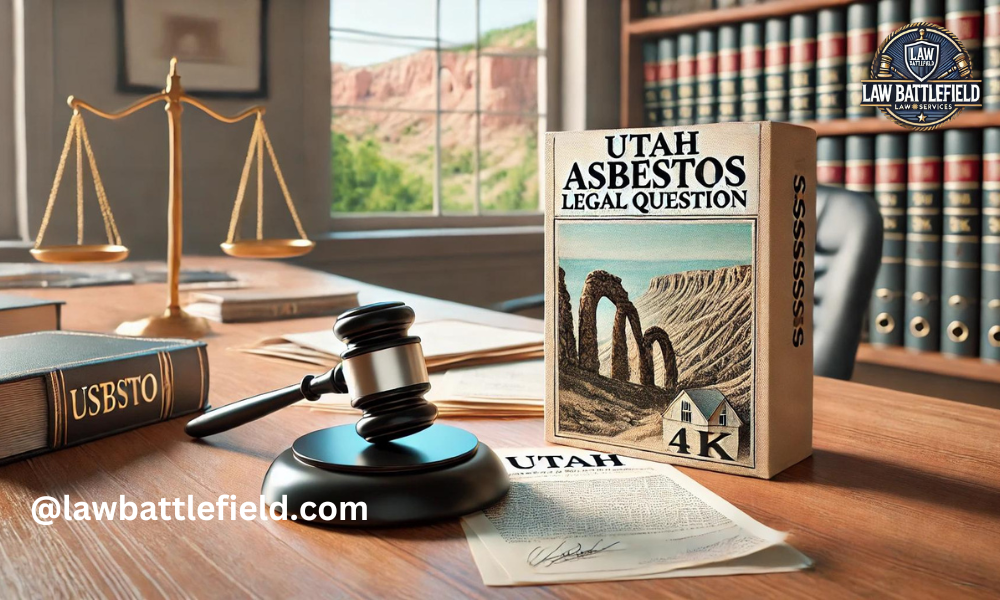Introduction To Utah Asbestos Legal Question
Asbestos is a natural mineral made up of tiny fibers that are strong and resistant to heat and fire. Because of these properties, asbestos was widely used in various construction materials like insulation, roofing, and floor tiles. However, asbestos is dangerous when its fibers are released into the air and inhaled. These fibers can get stuck in the lungs and other parts of the body, causing serious health problems over time.
Overview Of Asbestos And Its Use In Construction Materials
In Utah, asbestos was commonly used in homes, schools, and businesses built before the 1980s. It was added to products like cement, drywall, and pipe insulation to make them stronger and more resistant to fire. Asbestos is still found in many older buildings across Utah. If these materials are left undisturbed, they usually do not pose a risk. However, when these materials are damaged, renovated, or demolished, asbestos fibers can become airborne, which is dangerous.
Health Risks Associated With Asbestos Exposure
Exposure to asbestos is a serious health concern. Breathing in asbestos fibers can lead to diseases like lung cancer, asbestosis, and mesothelioma—a rare cancer that affects the lining of the lungs or abdomen. These diseases often take many years, even decades, to develop. Unfortunately, there is no safe level of asbestos exposure, meaning that even small amounts of inhaled fibers can pose a risk.
In Utah, the health risks associated with asbestos are a major legal concern. If you are exposed to asbestos at work or at home, you may have legal rights to seek compensation for medical costs, lost wages, and other damages. It is important to understand these risks and know your legal options if you or a loved one is affected by asbestos-related health issues.
What Is Asbestos?
Asbestos is a group of minerals that occur naturally as bundles of fibers. These fibers are heat-resistant, strong, and do not conduct electricity, which made asbestos very popular in construction and various industries. There are several types of asbestos fibers, but the most common ones are:
- Chrysotile: Often called “white asbestos,” it is the most commonly used type and can be found in roofs, ceilings, walls, and floors of homes and businesses.
- Amosite: Known as “brown asbestos,” it was used in cement sheets and pipe insulation.
- Crocidolite: Also called “blue asbestos,” it is less common but highly hazardous, used in steam engines, spray-on coatings, and cement products.
Common Uses Of Asbestos In Building Materials
Asbestos was widely used in construction materials due to its durability and resistance to fire. It was mixed with cement and other materials to create products like floor tiles, roof shingles, pipe insulation, and brake pads. In older buildings in Utah, asbestos can still be present in these materials. As long as these materials remain intact, they typically do not pose a health risk. However, when disturbed through renovation, demolition, or wear and tear, asbestos fibers can be released into the air.
How Asbestos Exposure Occurs
Asbestos exposure occurs when asbestos fibers are released into the air and inhaled or ingested. This can happen during construction work, home renovations, or when old asbestos-containing materials break down. Occupations like construction workers, miners, and shipyard workers are at higher risk of exposure. In Utah, asbestos exposure can also occur in older homes or buildings that contain asbestos materials.
Health Risks And Diseases Linked To Asbestos
Asbestos exposure is linked to several serious health conditions, including:
- Mesothelioma: A rare and aggressive cancer that affects the lining of the lungs, chest, or abdomen. It is almost exclusively caused by asbestos exposure.
- Asbestosis: A chronic lung disease caused by inhaling asbestos fibers, leading to lung tissue scarring.
- Lung Cancer: Long-term exposure to asbestos can increase the risk of lung cancer.
Common Symptoms And Delayed Onset Of Asbestos-Related Illnesses
Symptoms of asbestos-related diseases may take many years, often 20-50 years, to appear after exposure. Common symptoms include shortness of breath, persistent cough, chest pain, and unexplained weight loss. Because these symptoms are similar to other common conditions, they can be easily misdiagnosed.
The Importance Of Early Detection And Medical Consultation
Early detection of asbestos-related diseases is crucial because it can significantly improve treatment outcomes. If you suspect that you have been exposed to asbestos, consult with a medical professional immediately. Regular check-ups and informing your doctor about any asbestos exposure can help in early diagnosis and management of symptoms.
Asbestos Regulations In Utah
Utah has strict regulations to manage the risks of asbestos exposure. These rules aim to protect workers, residents, and the general public from asbestos hazards. Key regulations include:
- Compliance Requirements: Utah law requires proper handling, removal, and disposal of asbestos-containing materials. Only certified professionals are allowed to conduct asbestos abatement.
- Asbestos Removal and Abatement: Before any renovation or demolition, a thorough inspection for asbestos must be conducted. If asbestos is found, it must be removed by licensed contractors who follow safety protocols.
- Certified Professionals: Only licensed asbestos professionals can legally handle asbestos materials in Utah. They are trained to follow specific procedures that minimize the release of fibers into the air.
Understanding these regulations is important if you are dealing with asbestos in your home or workplace. Always hire certified professionals for asbestos testing, removal, and disposal to ensure compliance with Utah laws and to keep you and others safe. By staying informed about the Utah asbestos legal question, you can better navigate the challenges associated with asbestos exposure and ensure proper protection under the law.
Navigating The Utah Asbestos Legal Landscape
If you are exposed to asbestos in Utah, you have specific legal rights to protect your health and seek compensation for damages. Understanding these rights is crucial in navigating the Utah asbestos legal landscape. You may be entitled to pursue legal action if you develop an asbestos-related disease such as mesothelioma, lung cancer, or asbestosis. The types of lawsuits available include:
- Personal Injury Claims: If you develop an illness due to asbestos exposure, you can file a personal injury lawsuit against the parties responsible for your exposure, such as employers, manufacturers, or property owners.
- Wrongful Death Claims: Families who have lost a loved one to an asbestos-related disease can file a wrongful death lawsuit. This allows them to seek compensation for their loss, including medical expenses and funeral costs.
- Workers’ Compensation Claims: If you were exposed to asbestos at work, you might be eligible for workers’ compensation. This can cover medical bills and a portion of lost wages but typically does not cover pain and suffering.
How Recent Legislative Changes Impact Asbestos Litigation In Utah
Legislation regarding asbestos is constantly evolving, and recent changes in Utah can affect how asbestos cases are managed. New laws may influence the types of claims that can be filed, who can be held liable, and the compensation available to victims. Staying updated on these changes is vital, as they can impact the outcome of your case. Consulting with a knowledgeable attorney who understands the latest legal developments can help you navigate these complexities effectively.
Finding Legal Representation For Asbestos Cases In Utah
Finding the right attorney is a crucial step in pursuing an asbestos-related case in Utah. An experienced asbestos attorney can guide you through the legal process, from filing your claim to negotiating settlements or taking your case to trial. Here are some important considerations:
- Choose an Experienced Attorney: Look for a lawyer who specializes in asbestos litigation and has a proven track record of successful cases. Experience is key because asbestos cases can be complex and require specific legal knowledge.
- Questions to Ask When Hiring a Lawyer: When interviewing potential attorneys, ask about their experience with asbestos cases, their approach to handling your case, and their fee structure. Understanding how they plan to manage your case and any costs involved can help you make an informed decision.
- Resources for Finding Legal Representation in Utah: There are various resources available to help you find qualified asbestos lawyers in Utah. Consider contacting local bar associations, legal aid organizations, or online legal directories for recommendations.
Compensation And Legal Recourse For Asbestos Exposure Victims
Victims of asbestos exposure in Utah may be entitled to several types of compensation, which can help alleviate the financial burden caused by medical expenses and other damages. The types of compensation available include:
- Medical Costs: Coverage for treatment, medications, surgeries, and ongoing care.
- Lost Wages: Compensation for the income you have lost due to your inability to work.
- Pain and Suffering: Monetary compensation for the physical and emotional distress caused by asbestos-related diseases.
Steps In Filing A Claim And Pursuing Litigation
- Consult with an Attorney: Begin by meeting with an experienced asbestos attorney to discuss your case and determine the best course of action.
- Gather Evidence: Your attorney will help collect evidence of your asbestos exposure, medical records, and proof of the responsible parties.
- File a Claim: Your attorney will file the necessary legal documents to start your case.
- Negotiate or Go to Trial: Your attorney will negotiate a settlement with the responsible parties. If a fair settlement cannot be reached, your case may go to trial.
What to Do if the Asbestos Manufacturers Are Bankrupt
Many asbestos manufacturers have gone bankrupt due to the large number of claims filed against them. However, these companies often set up trust funds to compensate victims. If the company responsible for your exposure is bankrupt, your attorney can help you file a claim with these trust funds. This process can still provide you with the compensation you deserve, despite the company’s financial status.
Asbestos Abatement And Removal Guidelines
Asbestos abatement refers to the process of safely removing or containing asbestos materials to prevent exposure. In Utah, specific guidelines must be followed to ensure safety during asbestos removal in both residential and commercial properties.
- Safe Practices for Asbestos Removal: Asbestos removal should only be performed by certified professionals who are trained to handle hazardous materials. The process typically involves sealing off the area, using wet methods to minimize dust, and using protective gear to prevent exposure. Air monitoring is often required to ensure that asbestos fibers are not released into the environment.
- Legal Responsibilities of Property Owners and Contractors: In Utah, property owners and contractors have a legal responsibility to manage asbestos safely. Before any renovation or demolition, a thorough asbestos inspection is required. If asbestos is found, it must be removed by licensed asbestos abatement professionals. Property owners must ensure compliance with state and federal asbestos regulations to avoid legal consequences.
- Procedures and Certifications Required for Asbestos Abatement: Only licensed and certified professionals are allowed to conduct asbestos abatement. They must follow strict procedures, including obtaining necessary permits, using proper equipment, and disposing of asbestos waste in designated facilities. Certifications for asbestos professionals are issued by regulatory bodies and require regular training and renewal.
Common Questions About Asbestos Legal Issues In Utah
Understanding the legal aspects of asbestos exposure is crucial for anyone affected. Here are some common questions related to asbestos legal issues in Utah:
- How to Identify Asbestos Exposure and Legal Implications: Asbestos exposure can occur in older buildings or during specific job activities. Symptoms of asbestos-related illnesses, like shortness of breath or persistent cough, often appear years after exposure. Legally, individuals who have been exposed to asbestos may have grounds to file a claim for damages, especially if the exposure occurred due to negligence by employers or property owners.
- Frequently Asked Questions About Asbestos Claims and Legal Options: Many people wonder about their legal options if they or a loved one are diagnosed with an asbestos-related illness. Common questions include: “What types of compensation are available?”, “How do I file a claim?”, and “Do I need a lawyer?” Understanding these questions and seeking professional legal advice can help guide you through the process of pursuing a claim.
Recent Developments And Future Outlook In Utah Asbestos Laws
Asbestos laws and regulations are continually evolving, and staying informed about recent changes is essential.
- Overview of Recent Legal Changes and Court Decisions: Recent legal changes in Utah have impacted how asbestos cases are managed. For instance, updates to asbestos removal regulations or new court decisions can influence the eligibility for compensation and the legal responsibilities of property owners and contractors. Keeping up-to-date with these changes can help individuals and businesses navigate the legal landscape more effectively.
- Future Trends in Asbestos Regulations and Litigation: Future trends in asbestos law may include stricter regulations on asbestos use, removal, and disposal. Additionally, advancements in medical research may influence how asbestos-related cases are litigated, potentially expanding the types of compensable damages.
- The Importance of Staying Informed About Ongoing Legal Developments: Staying informed about asbestos laws and regulations is crucial for property owners, contractors, and individuals exposed to asbestos. Regularly reviewing updates from regulatory agencies and consulting with legal professionals can ensure compliance and help protect your rights.
Conclusion
Handling asbestos-related legal questions in Utah requires a clear understanding of both the health risks and legal implications of asbestos exposure. Property owners and contractors have significant responsibilities to manage asbestos safely, and individuals exposed to asbestos have legal rights to seek compensation.
It is crucial to seek legal help from experienced asbestos attorneys who can guide you through the complexities of filing a claim and pursuing compensation. Protecting your health and legal rights involves staying informed about current and future asbestos regulations. By understanding these aspects, you can navigate the challenges of asbestos exposure and legal issues in Utah with greater confidence.
FAQs
What Should I Do If I Suspect Asbestos In My Home?
If you suspect asbestos in your home, avoid disturbing the material and contact a licensed asbestos inspector. They can assess the situation and recommend safe removal methods if needed.
Can I Remove Asbestos Myself In Utah?
No, asbestos removal should only be performed by certified professionals in Utah. Handling asbestos without proper training and equipment can pose serious health risks.
What Types Of Compensation Are Available For Asbestos Exposure Victims?
Victims may be entitled to compensation for medical costs, lost wages, pain and suffering, and other damages. The specific compensation depends on the nature of the exposure and the severity of the illness.
How Do I File An Asbestos Claim In Utah?
Filing a claim involves consulting with an experienced asbestos attorney who can guide you through the process. They will help gather evidence, file the necessary paperwork, and represent your interests in negotiations or court.
What Happens If The Company Responsible For Asbestos Exposure Is Bankrupt?
If the company is bankrupt, you may still be able to file a claim with an asbestos trust fund established to compensate victims. Your attorney can help identify the appropriate trust and assist with the claims process.
How Long Does It Take For Symptoms Of Asbestos Exposure To Appear?
Symptoms of asbestos-related diseases often take 20-50 years to develop. Common symptoms include persistent cough, chest pain, and shortness of breath. Early detection is critical for managing these conditions.
Do All Asbestos Exposure Cases Qualify For A Lawsuit?
Not all cases qualify for a lawsuit. Eligibility depends on factors like the extent of exposure, the resulting illness, and whether negligence can be proven. Consulting with an asbestos attorney can help determine your legal options.
Was this article helpful? Check out more on Lawbattlefield.com
Lebanon Mesothelioma Legal Questions: Know Your Rights And Legal Options





